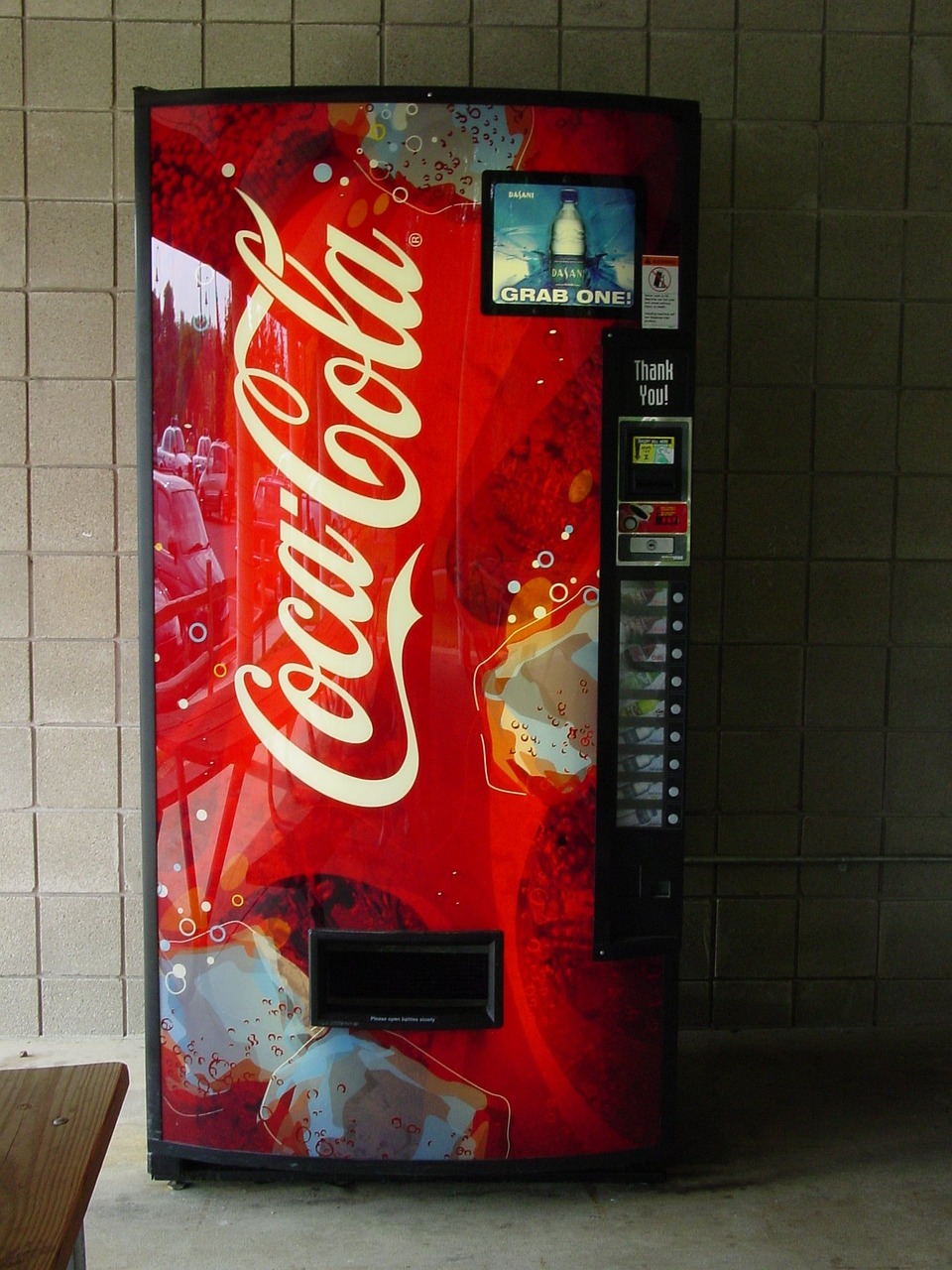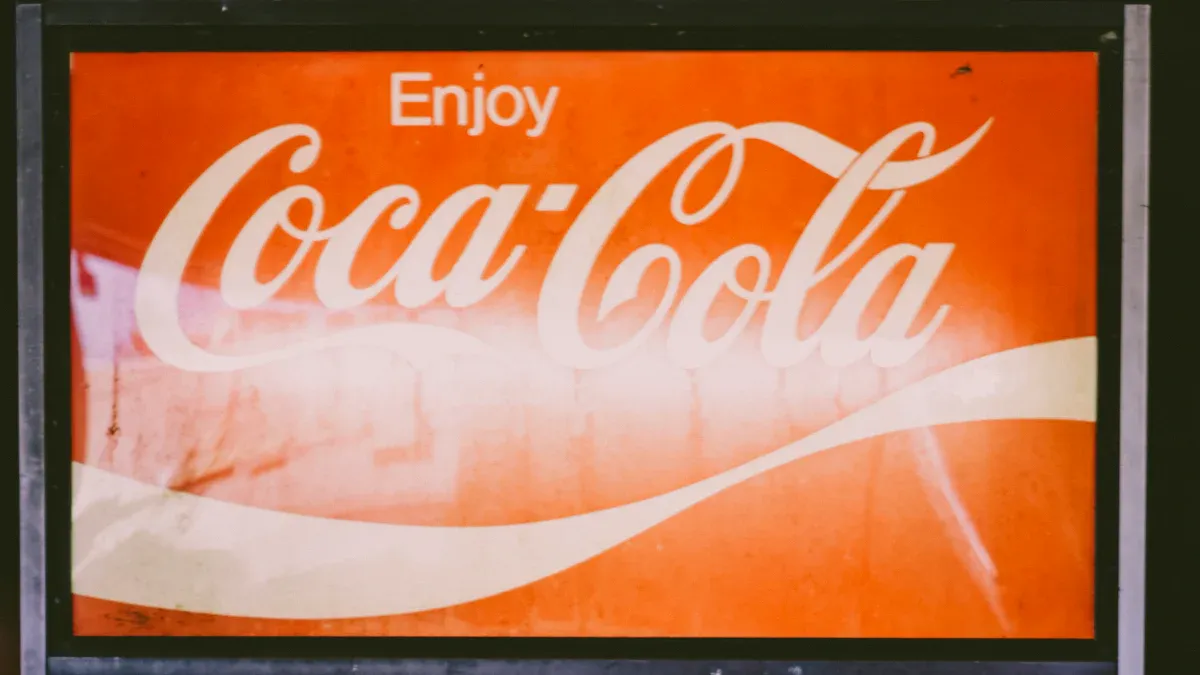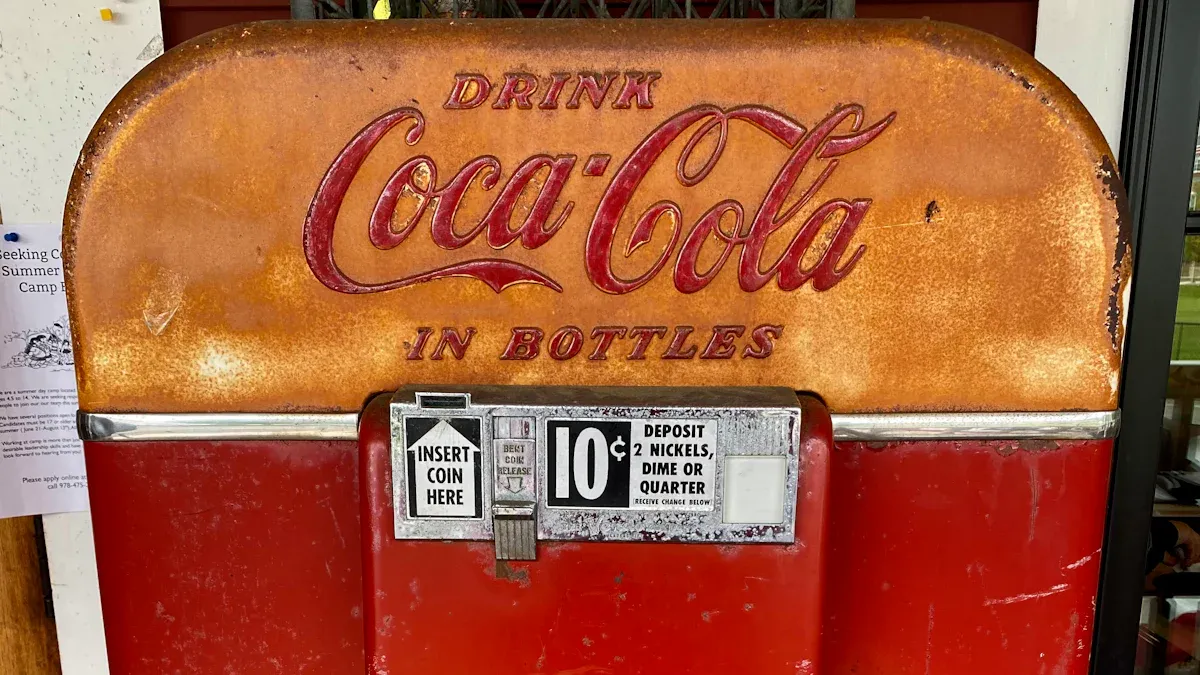The Nostalgic Evolution of 2000s Soda Vending Machines

Do you remember the thrill of finding a soda vending machine on a hot day? Those machines weren’t just about grabbing a drink—they were tiny time capsules of convenience and excitement. Their bold designs and glowing buttons made every encounter feel special. You’d press a button, hear the hum of the machine, and out came your favorite soda. It was more than a transaction; it was an experience. These vending machines became a part of daily life, blending seamlessly into schools, malls, and workplaces. They hold a unique place in history, showcasing the nostalgic evolution of technology and culture.
Key Takeaways
Soda vending machines in the 2000s were more than drink sellers. They stood out with bold looks and famous logos.
Digital screens and touch buttons made them easy to use. Buying a drink became a fun, interactive experience.
Paying without cash changed vending. It made buying faster and easier. People didn’t need exact change anymore.
New cooling systems saved energy and cut costs. They also helped the environment, showing care for the planet.
Today’s vending machines, like Cloudpick's Unmanned Store, are smarter. They focus on being fast, easy, and automated.
Iconic Designs of 2000s Soda Vending Machines

Bold colors and nostalgic branding
You probably remember the bold colors that made soda vending machines impossible to miss. Bright reds, blues, and greens weren’t just eye-catching—they were part of the branding that made these machines feel familiar. Coca-Cola’s iconic red machines or Pepsi’s cool blue designs instantly told you what drinks were inside. These colors weren’t random; they were carefully chosen to evoke emotions and create a sense of trust. The logos and slogans plastered across the machines added to their charm. They weren’t just selling soda; they were selling a piece of history. Every time you saw one, it felt like a small reminder of the brands you grew up with.
The rise of digital displays and touch buttons
The 2000s brought a wave of innovation to vending machines. You might recall the excitement of seeing digital displays for the first time. These screens replaced the old mechanical buttons, making the machines feel futuristic. Touch buttons added a sleek, modern vibe, letting you select your favorite drinks with just a tap. Some machines even displayed animations or advertisements, turning a simple purchase into an interactive experience. These upgrades weren’t just about looks—they made the machines easier to use and more efficient. You didn’t have to guess if your soda was available; the display told you everything.
Compact designs for urban spaces
As cities grew, vending machines adapted to fit into tighter spaces. Compact designs became a trend, especially in urban areas where every square foot mattered. You’d find smaller machines tucked into subway stations, office corners, and school hallways. These beverage vending machines were designed to be practical without losing their appeal. They still offered a variety of drinks, but their slim profiles made them perfect for crowded places. Their presence in these spaces wasn’t just convenient—it was a reminder of how vending machines evolved to meet your needs.
Technological Milestones in the Evolution of Vending Machines
Cashless payment systems and their impact
Do you remember the days of fumbling for coins to grab a soda? The 2000s marked a turning point when vending machines began embracing cashless payment systems. Suddenly, you could use a credit card or even a prepaid card to make your purchase. This shift wasn’t just about convenience—it completely transformed how you interacted with vending machines. Payments became faster, and you didn’t have to worry about carrying exact change anymore.
For businesses, this was a game-changer. Cashless systems reduced the risk of theft and made it easier to track sales. They also opened the door for more advanced features, like loyalty programs and personalized offers. You might have even noticed some machines offering discounts or rewards for frequent purchases. This innovation didn’t just improve the vending experience; it set the stage for the digital payment methods we rely on today.
Early energy-efficient cooling technologies
If you’ve ever wondered how vending machines kept your drinks ice-cold without guzzling electricity, the answer lies in early energy-efficient cooling technologies. In 2004, the ENERGY STAR program introduced new standards for refrigerated vending machines. These machines were designed to be 35% more efficient than older models. Over time, they saved up to 50% in energy costs within just three years.
What did this mean for the environment? A lot. By 2012, these energy-efficient machines were saving around $150 per year per machine. Across the country, that added up to over 5.5 billion kWh of electricity saved annually. This wasn’t just about cutting costs—it also prevented four million metric tons of greenhouse gas emissions. These advancements showed how vending machines could evolve to be both practical and eco-friendly, paving the way for even greener technologies in the future.
Automation in restocking and maintenance
Have you ever wondered how vending machines always seemed stocked with your favorite drinks? Automation played a huge role in making that happen. In the early 2000s, vending machines began incorporating real-time inventory tracking and automated restocking systems. These features allowed businesses to monitor stock levels remotely and refill machines before they ran out of popular items.
This wasn’t just about keeping you happy as a customer. Automation also made vending operations more efficient. Machines could now alert operators about maintenance issues, reducing downtime and ensuring a smoother experience for you. Some machines even took it a step further, integrating advanced mechanisms for dispensing items like trading cards or snack food vending machine products. These innovations reflected a broader trend in automated retail, where convenience and accessibility became the top priorities.
Fun Fact: The evolution of vending machines didn’t stop there. These early automation features laid the groundwork for today’s smart vending solutions, which use AI to predict demand and optimize operations.
Cultural Significance of Soda Vending Machines in the 2000s

A symbol of convenience and modernity
In the 2000s, soda vending machines became more than just a way to grab a quick drink. They symbolized convenience and modernity, fitting seamlessly into your fast-paced life. Whether you were rushing to catch a train or taking a break at work, these machines were always there, ready to serve you. Their sleek designs and advanced features, like cashless payments and digital displays, made them feel futuristic. You didn’t have to wait in line or deal with a cashier. Just press a button, and your favorite soda or drink was in your hands.
These machines also reflected the growing trend of instant gratification. People wanted things faster and easier, and vending machines delivered. They weren’t just about selling drinks; they represented a shift in how you accessed everyday items. This blend of convenience and innovation made them a staple in urban life, showing how technology could make even the smallest moments more efficient.
Their role in schools, malls, and workplaces
You probably remember seeing vending machines everywhere in the 2000s. Schools, malls, and workplaces were some of their most common homes. In schools, they were a favorite hangout spot. Students would gather around them during breaks, debating over which soda or snack to choose. These machines weren’t just about quenching thirst; they became part of the social fabric, creating small moments of connection.
In malls, vending machines added to the shopping experience. After walking around for hours, you could count on them for a refreshing drink or a quick snack. They were strategically placed in food courts, hallways, and even parking lots, making them impossible to miss. Workplaces also embraced vending machines as a way to boost employee satisfaction. A quick trip to the break room for a cold soda or a snack food vending machine treat could brighten your day and keep you energized.
Their presence in these spaces wasn’t random. It showed how vending machines adapted to meet your needs, no matter where you were. They became a reliable part of your daily routine, blending convenience with accessibility.
How they became a cultural icon of the 2000s
By the 2000s, vending machines had cemented their place as cultural icons. They weren’t just functional; they were everywhere, shaping how you interacted with the world around you. In Japan, for example, vending machines reached their peak with over 5.6 million machines in operation. That’s about one machine for every 23 people! This density made them an integral part of daily life, offering everything from drinks to unique items like toys and even umbrellas.
The nostalgic evolution of these machines also played a role in their iconic status. Their bold colors, familiar branding, and innovative features made them memorable. They weren’t just machines; they were part of your history. Whether you were grabbing a soda on a hot day or trying out a new snack, these moments became small but meaningful experiences.
Vending machines also reflected the culture of the time. They showed how technology could make life easier while still being fun and engaging. Their ability to adapt to different environments and needs made them more than just a convenience—they became symbols of progress and innovation. Even today, when you think back to the 2000s, vending machines stand out as a defining feature of that era.
The Transition to Modern Vending Solutions
The rise of health-conscious trends
Have you noticed how vending machines are no longer just about sugary sodas and salty snacks? Today, they’re catering to a growing demand for healthier options. You’ll find machines stocked with organic snacks, low-calorie beverages, and even protein bars. This shift reflects how much people care about wellness. Schools and fitness centers are leading the way, installing vending machines that offer nutritious choices.
The trend isn’t just about what’s inside the machine—it’s about meeting your needs. Operators are investing in healthier products because they know you’re looking for better options. In the U.S., for example, vending machines now focus on ready-to-eat meals and organic snacks. This change shows how the industry is evolving to keep up with your lifestyle.
The shift to smart vending machines
Vending machines have come a long way since the 2000s. Today, they’re smarter than ever, thanks to cutting-edge technology. Imagine a machine that knows when it’s running low on stock or can predict what you’ll want to buy next. That’s the power of smart vending machines. They use tools like AI, IoT, and RFID to track inventory in real time and even perform predictive maintenance.
These advancements aren’t just cool—they’re practical. Smart machines reduce operational costs and make your experience smoother. The market for these machines is growing fast, with a projected annual growth rate of 6.8% from 2025 to 2033. It’s clear that smart vending is the future, offering efficiency and convenience like never before.
Feature | Benefit |
|---|---|
Real-time inventory | Ensures your favorite items are always in stock. |
Predictive maintenance | Reduces downtime and keeps machines running smoothly. |
AI-driven personalization | Offers tailored recommendations based on your preferences. |
Cloudpick’s Unmanned Store: A modern evolution of vending machines
If you think vending machines are impressive, wait until you hear about Cloudpick’s Unmanned Store. This isn’t just a machine—it’s a fully automated shopping experience. Using advanced AI technology, the Unmanned Store takes convenience to a whole new level. You can walk in, grab what you need, and leave without waiting in line or scanning items.
The store’s smart cameras and real-time monitoring ensure everything runs smoothly. It even supports over 60 payment methods, making it accessible to everyone. Whether you’re shopping solo or with family, the Unmanned Store adapts to your needs. It’s compact, efficient, and ready for global deployment.
Cloudpick’s innovation shows how far vending has come. From simple soda machines to AI-powered retail spaces, the journey reflects a commitment to making your life easier. The Unmanned Store isn’t just the future of vending—it’s here now, reshaping how you shop.
The 2000s soda vending machines weren’t just machines; they were part of your daily life. Their nostalgic evolution reminds you how technology can turn simple moments into lasting memories. These machines didn’t just serve drinks—they shaped your experience of convenience and modernity.
Today, their legacy inspires innovation. From touch buttons to cashless payments, the evolution of vending machines paved the way for smarter solutions. Brands like Cloudpick are taking this further with AI-powered unmanned stores, redefining what vending can be. It’s exciting to see how far vending has come, and it’s clear the journey is far from over.
FAQ
What made 2000s soda vending machines so memorable?
Their bold designs, glowing buttons, and nostalgic branding created a unique experience. You’d press a button, hear the hum, and out came your favorite drink. These machines weren’t just functional—they were part of your daily life.
How did vending machines evolve technologically in the 2000s?
They introduced cashless payments, energy-efficient cooling, and automated restocking. These features made the machines faster, smarter, and more eco-friendly. They set the stage for today’s advanced vending solutions.
Are vending machines still relevant today?
Absolutely! Modern vending machines have evolved into smart systems. They use AI to track inventory, predict demand, and personalize your shopping experience. They’re more efficient and convenient than ever.
What is Cloudpick’s Unmanned Store?
It’s an AI-powered retail solution that takes vending to the next level. You walk in, grab what you need, and leave—no lines, no scanning. This machine redefines convenience with real-time monitoring and global payment options.
How do vending machines reflect cultural trends?
They adapt to your needs. In the 2000s, they symbolized convenience and modernity. Today, they cater to health-conscious lifestyles and tech-savvy shoppers. Their evolution mirrors changes in society and technology.
See Also
The Journey of Mountain Dew Vending Machines Through Time
Vending Machines: A Transformation From Snacks to Smart Devices
Exploring Antique Vending Machines: From Sacred Water to Soda
